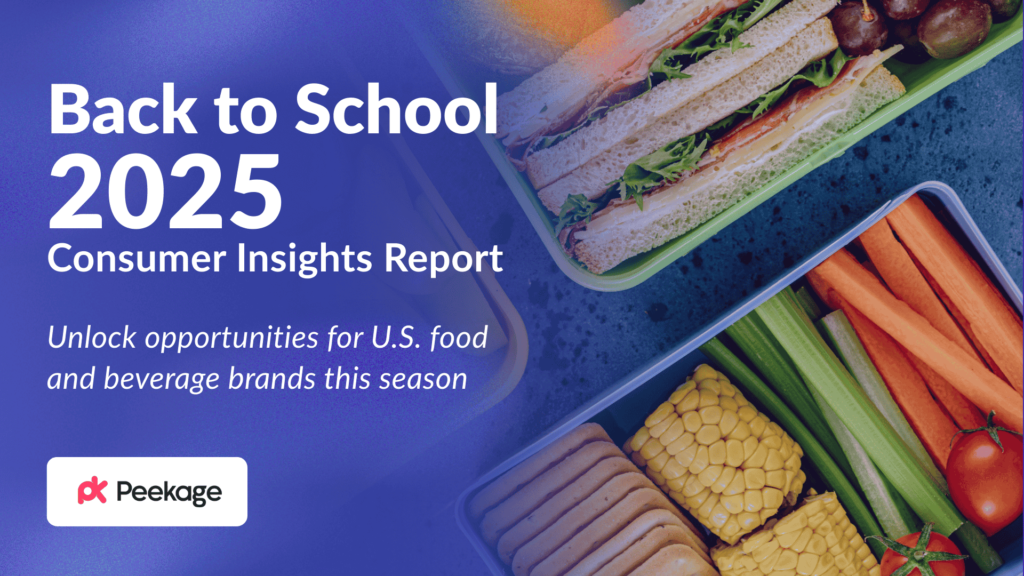In this edition of Munch & Market Memo, we focus on the holiday season's impact on consumer behavior within the CPG industry. We'll explore key trends shaping food and beverage discoveries, holiday spending habits, shopping timing, favorite festive dishes and more.
Holiday Editions vs. Regular Products
A fascinating insight into consumer preferences: more than two-thirds of consumers enjoy the best of both worlds, showing equal preference for special holiday editions and standard versions of products. This highlights a versatile consumer base open to both seasonal novelty and the comfort of familiar products. Meanwhile, about 1 out of 7 consumers lean towards the exclusivity of holiday-specific editions, indicating a niche market for products that capture the festive spirit. On the other hand, 16.7% stay loyal to regular versions, valuing consistency over seasonal variations.
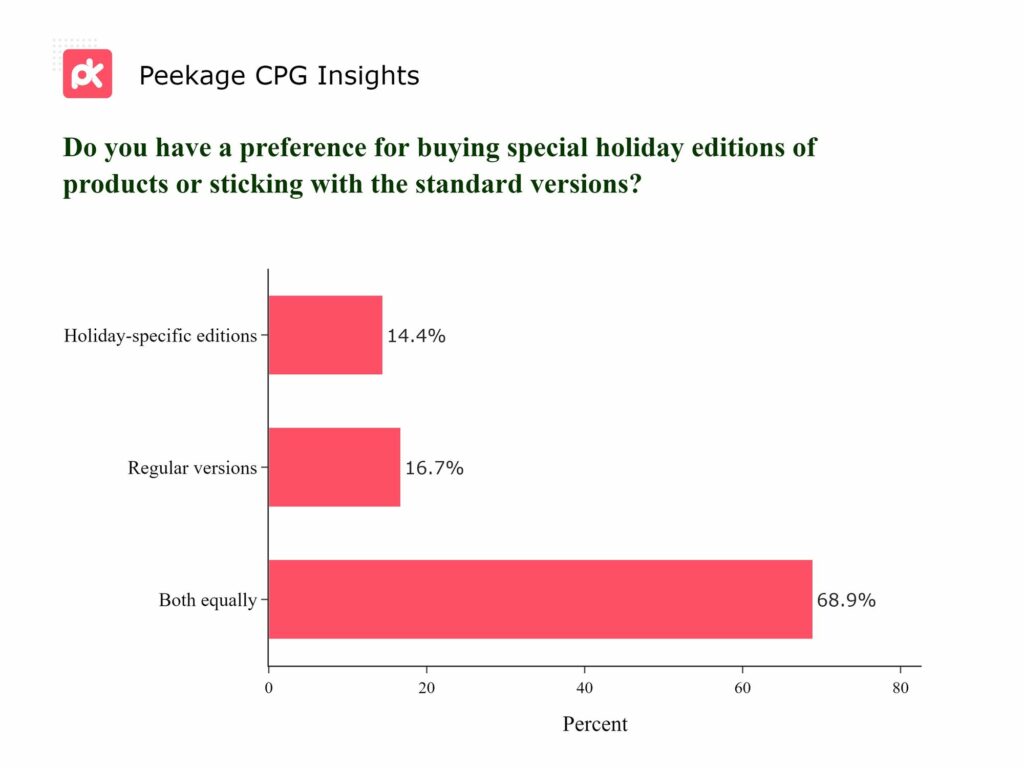
The consumer preference for both holiday editions and regular products suggests that CPG brands should offer a blend of seasonal novelty and familiar staples to cater to a versatile market.
Health and Nutrition in Holiday Choices
When it comes to health and nutrition in holiday food and beverage choices, consumer attitudes vary. About 1 in 6 places it as their primary concern, always prioritizing health above all. For over 1 in 3, it's important but takes a backseat to other factors like taste or tradition. Nearly 1 in 5 give it minor consideration, and notably, almost 1 in 5 don't consider it at all during the festive indulgence.
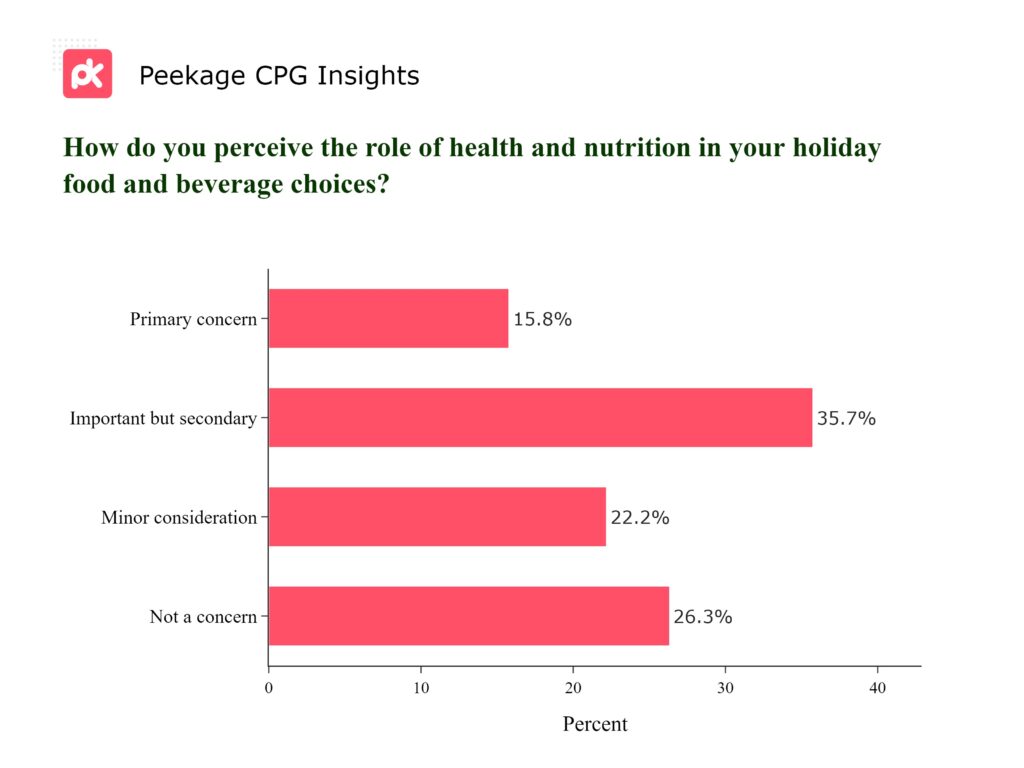
The varied importance consumers place on health and nutrition suggests that CPG brands should offer a range of options. From health-focused products to indulgent treats, catering to this spectrum of consumer health priorities can maximize appeal during the holiday season.
Top Channels for Discovering Holiday Food & Beverages
When it comes to finding new food and beverage items for the holiday season, three channels stand out prominently. Supermarket displays and promotions lead the charge, followed closely by the power of word of mouth and the influence of social media influencers. These methods are more than twice as popular as other channels like food and beverage magazines, food festivals or events, and email newsletters.
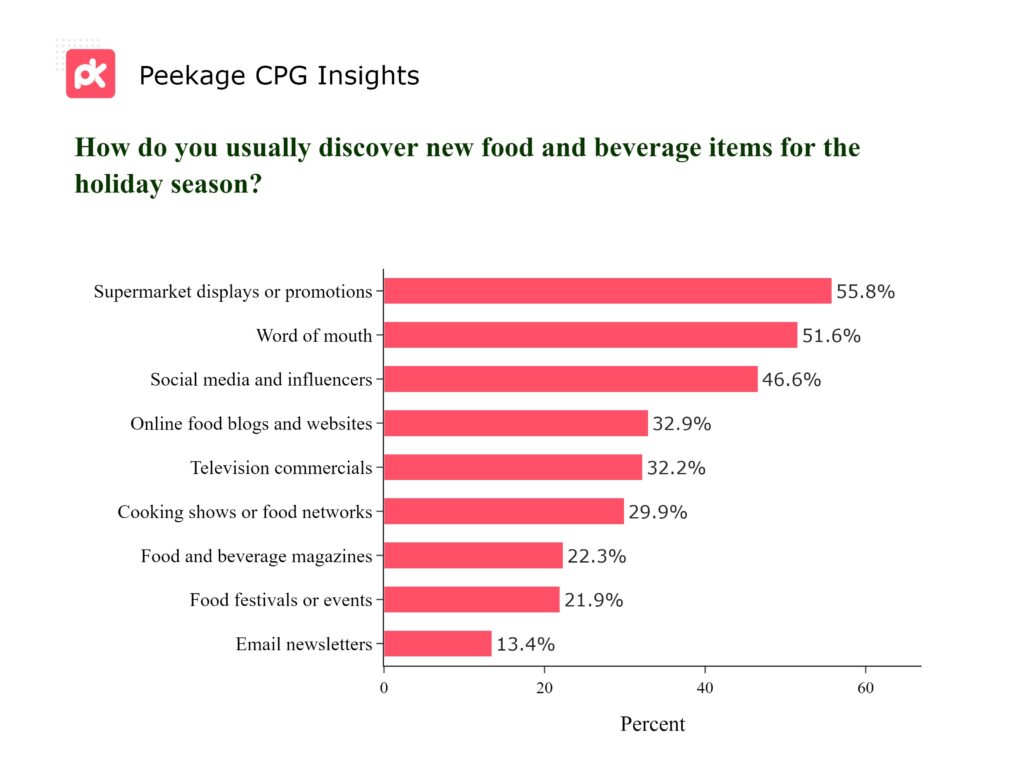
For CPG brands, the dominance of supermarket displays and promotions, word of mouth, and social media influencers in driving holiday food and beverage discoveries highlights the need to focus marketing efforts on these channels. Their effectiveness, being more than twice that of traditional channels, underscores the importance of visual appeal, personal recommendations, and digital influence in consumer decision-making.
The Role of Convenience in Holiday Food Purchases
Convenience in holiday food and beverage has some importance. A notable 24.5% of consumers find it very important, seeking out ready-to-eat and easy-to-prepare options to simplify their festive preparations. In contrast, 11.6% don't consider convenience important at all, perhaps valuing other aspects like tradition or quality more. The largest group, 46.5%, deem it somewhat important, indicating a balanced approach to convenience and other factors. Meanwhile, 17.4% view it as somewhat unimportant, suggesting a willingness to invest more time and effort into their holiday meals.
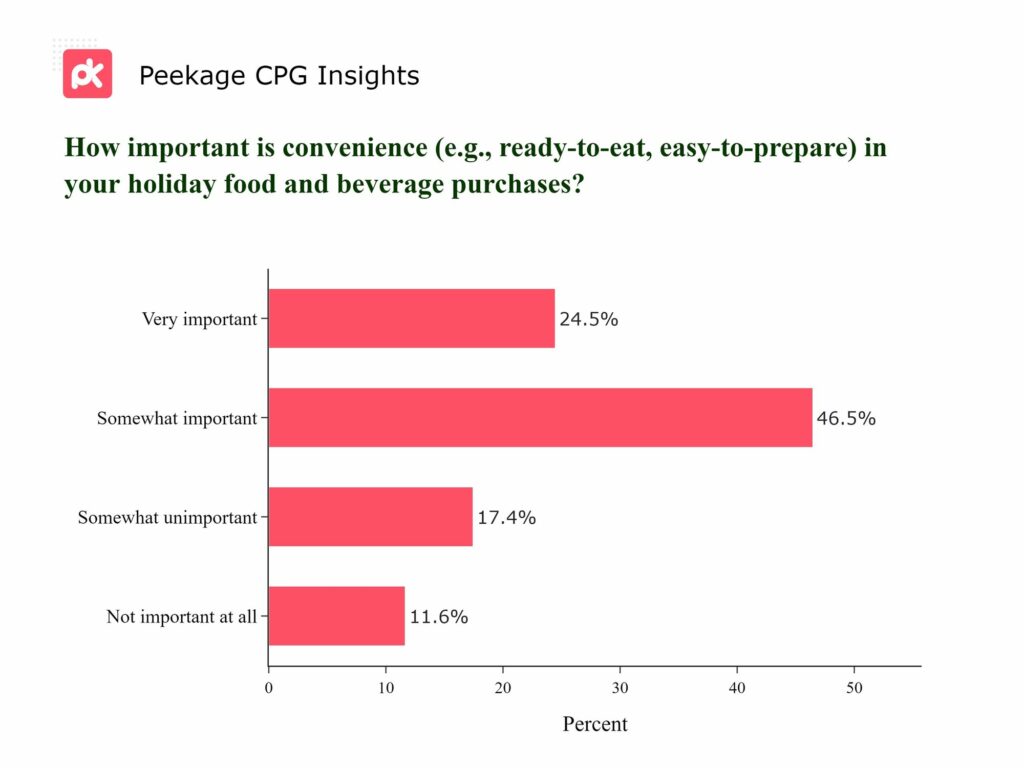
CPG brands should offer a range of options. From quick, easy-to-prepare items to more elaborate, traditional fare, accommodating these diverse convenience preferences can cater to the full spectrum of consumer needs during the holidays.
Holiday Spending on Food & Drinks: What's the Budget?
Inflation and rise of grocery costs had their impact on holiday spending per family member too. A big chunk of consumers, 38.6%, are budget-conscious with spending under $200. But, 36.3% are in the $200-$400 zone, balancing festivity with finance. On the higher end, 15.3% are splurging between $400-$600, and then there are the 9.7% big spenders, going over $600. It's a spread from savvy savers to lavish spenders everyone’s got their own holiday budget playbook.

These varied holiday spending habits indicate a market segmented by budget: a large base seeks value (under $200), a significant portion spends moderately ($200-$400), while a smaller, affluent group opts for premium purchases (over $400). Brands can thrive by diversifying their offerings to cater to these distinct spending capacities, ensuring appeal across the budget spectrum during the festive season.
Navigating Holiday Shopping Hurdles
The holiday shopping saga has its twists and turns. Top challenge? Inflation and rising costs, affect a whopping 64.4%. Crowds and long lines follow, irking 37.2%. And it's not just about finding what you want 34.8% struggle with availability. Balancing shopping time with life? Yep, 25.3% feel that. Shipping woes hit 22.1%, while 16.2% are on the hunt for quality. New product discovery? A puzzle for 15%. And let's not forget health and safety concerns (13.6%). Even in a season of joy, the shopping journey has its bumps.
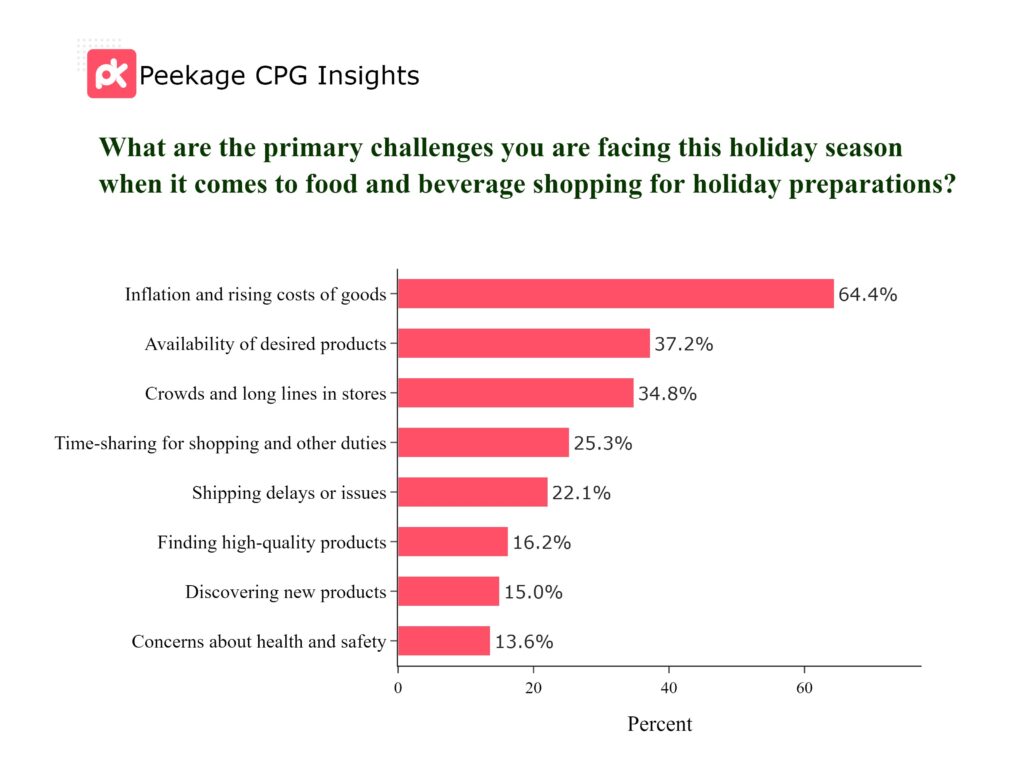
CPG brands should be mindful of pricing strategies, efficient in-store/online experiences, and ensuring consistent stock. Addressing these pain points, along with balancing convenience and quality, can enhance customer satisfaction during the festive rush.
Choosing Stores for Holiday Shopping: What Drives Us?
This holiday season, the 'why' behind store choice is clear. A massive 75.8% are drawn by price and deals - wallet wisdom reigns supreme. But don't overlook convenience and location, key for 55.7%. Product availability (56.2%) and variety (48.5%) are also big - variety is the spice of life, after all. Reputation matters too, influencing 28.8%, while 27.8% value customer service - a friendly face goes a long way. Atmosphere sets the mood for 23.2%, making shopping more than just a chore. And hey, 14.8% are looking for hassle-free delivery. It's a blend of savings, convenience, and experience.
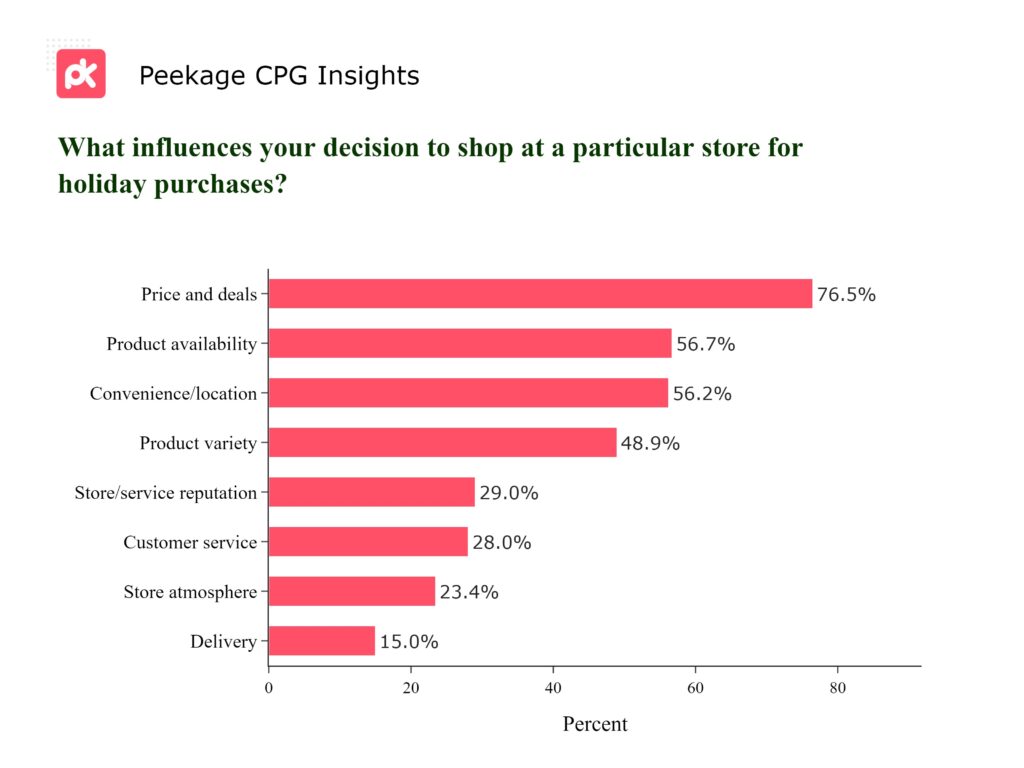
This holiday season, prioritize competitive pricing and attractive deals, ensure a diverse and readily available product range, and focus on enhancing the overall shopping experience, both in-store and online. Catering to these key consumer preferences - value, variety, and convenience - will be crucial for success.
What Makes an Online Store Click for Holiday Shoppers?
In the digital shopping spree, price is king, with 29.0% hunting for competitive pricing and deals. But fast and free shipping isn't far behind, tempting 22.6% of online shoppers. A wide product range captures the interest of 11.5%, ensuring something for every taste. Then there's the allure of the exclusive 7.6% are drawn to limited-edition products. Surprisingly, only 6.7% are swayed by positive reviews, and the same percentage by loyalty perks. User experience and security matter too, but less so. It's a mix of saving, speed, variety, and exclusivity driving the online holiday rush.
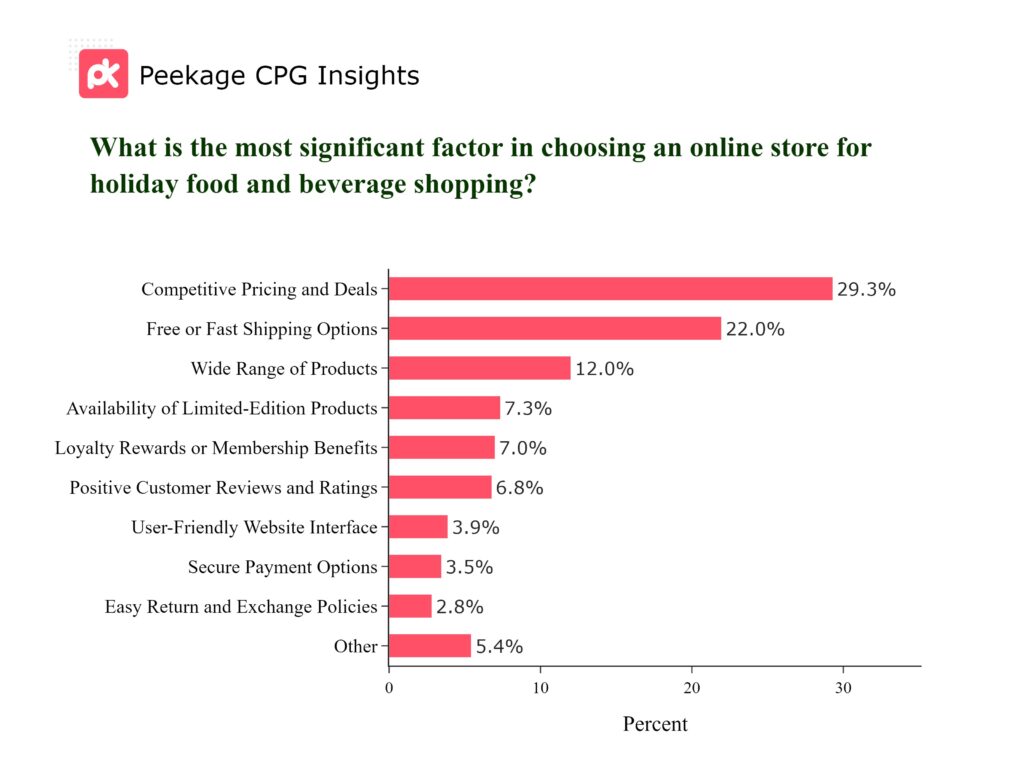
In the digital holiday shopping realm, CPG brands should prioritize competitive pricing (29.0%) and offer fast, free shipping (22.6%) to appeal to cost-conscious and convenience-seeking consumers. Additionally, providing a wide range of products and exclusive, limited-edition items can cater to diverse tastes and preferences, enhancing the online shopping experience and attractiveness.
Shopping Timing for Food and Beverage: Holiday Deals Impact
In the realm of holiday shopping, consumers show diverse preferences. A small yet significant 11.1% are avid deal-seekers, always on the lookout for holiday bargains like Black Friday and Cyber Monday. Meanwhile, the largest group, at 42%, falls into the 'sometimes' category, indicating a more opportunistic approach to deals. Interestingly, 21.6% rarely chase these deals, and 25.3% aren't swayed by holiday discounts at all.
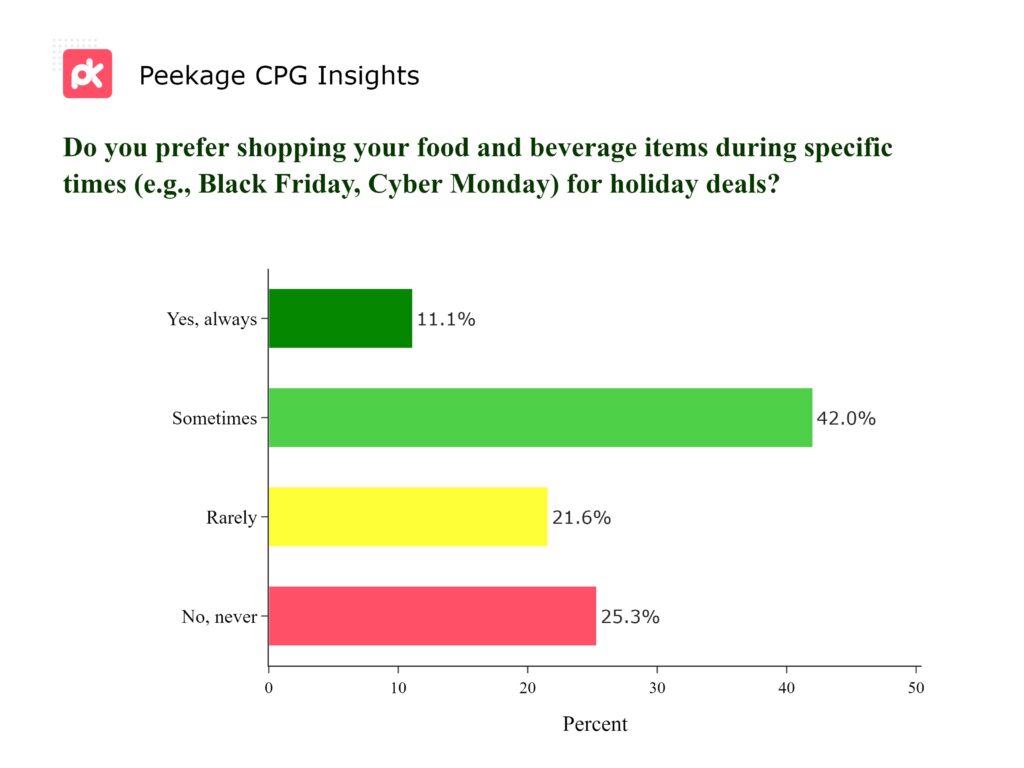
For FMCG brands, this means a nuanced approach is key: while flashy deals can attract a portion of the market, maintaining consistent value and appeal is crucial for the rest.
Switching Holiday Food & Beverage Brands: What's the Push?
The holiday season brings shifts in brand loyalty, and here's why: Price cuts and sales are a huge magnet, pulling in 65.9% of consumers. Product availability keeps 52.5% of shoppers flexible, ensuring they get what they need, when they need it. Unique or limited edition products have a strong allure, tempting 37.0%, while recommendations from friends or family sway 39.7%. Quality isn't to be overlooked, with 33.5% switching for a better product. Sustainability and ethical practices have a niche but notable impact, drawing 13.1% and 11.3% respectively. It's a blend of budget-friendliness, social influence, quality, and availability driving brand choices.
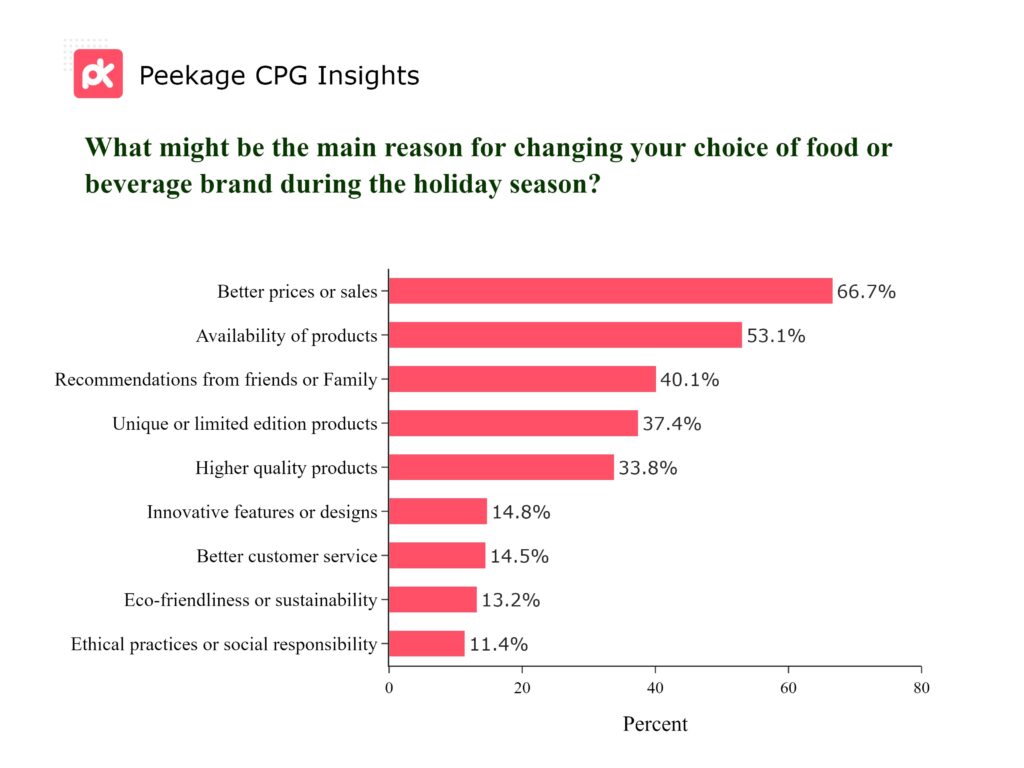
During the holiday season, CPG brands should focus on competitive pricing and sales (65.9%) and ensure product availability (52.5%) to retain and attract customers. Additionally, offering unique or limited edition products (37.0%) and maintaining high quality (33.5%) are crucial. Leveraging social recommendations and catering to the growing interest in sustainability and ethical practices can further influence consumer brand choices.
Timing the Holiday Shop: When Do We Start?
Holiday shopping timing? It's a calendar mix! A strategic 35.1% start a few weeks before, beating the rush. Then there's the 32.5% who dive in a week before, embracing the holiday hustle. For the early birds, 13.5% get going more than a month in advance talk about planning! Surprisingly, 13.9% are last-minute shoppers, riding the festive wire. And hey, 5% just skip the holiday shopping frenzy altogether. From planners to procrastinators, everyone's got their own holiday shopping rhythm.

CPG brands should be prepared for a surge in demand a few weeks before the holidays, as 35.1% of consumers start their shopping then. Additionally, ensuring stock availability and efficient customer service is crucial up to the last minute, catering to the 13.9% of last-minute shoppers. A steady and well-managed supply chain throughout the holiday season will cater to the diverse shopping schedules of consumers.
Holiday Shopping Avenues: Where Are We Heading?
For holiday food and beverage shopping, local supermarkets are the go-to for a whopping 80.6%, blending convenience with variety. Wholesale or bulk stores attract 29.0% of shoppers, appealing to those stocking up for the season. Meanwhile, 23.2% enjoy the freshness and local flair of farmers' markets. Specialty food stores (21.9%) and online platforms (21.4%) cater to specific tastes and convenience-seekers. Home delivery services and direct purchases from producers like wineries and farms add to the mix, offering convenience and quality. Even convenience stores snag 22.7%, proving handy for last-minute grabs. It's a diverse shopping landscape, from digital carts to market stalls.
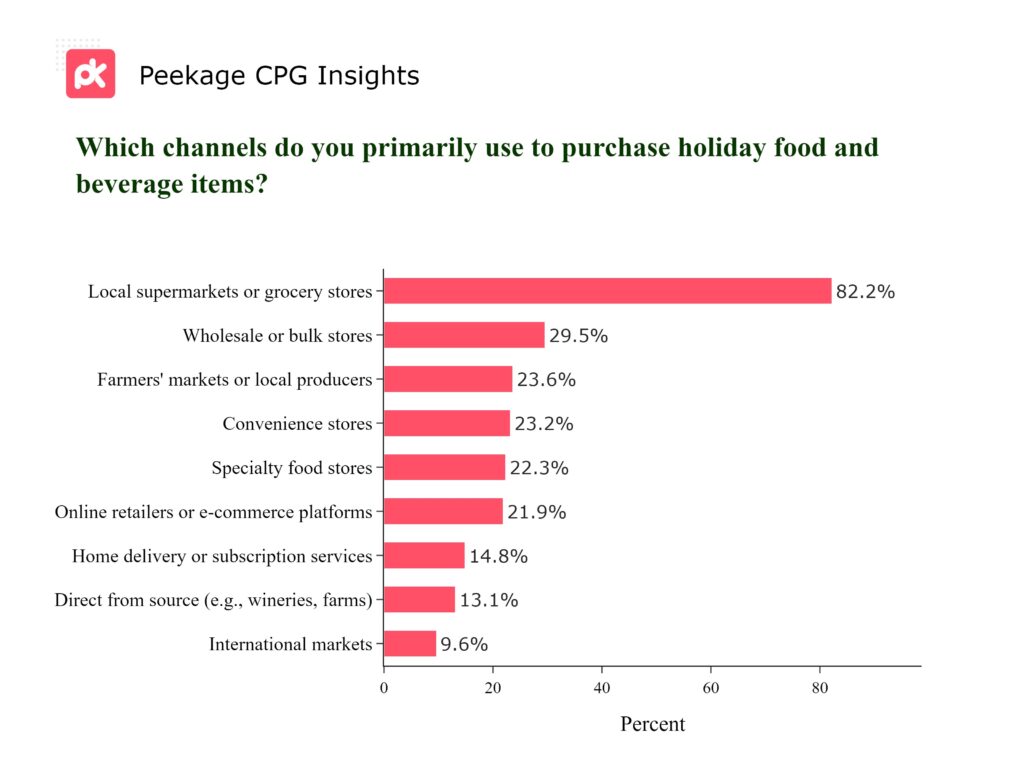
CPG brands should focus on a presence in local supermarkets, where 80.6% of holiday shopping occurs, while also catering to niche markets in wholesale stores, specialty shops, and online platforms. Versatility across various shopping channels is key.
Driving Holiday Food & Drink Choices: What Matters Most?
When it comes to holiday food and beverage choices, taste is king for 64.4% of consumers. However, traditions and habits also play a key role for 50.5%, intertwining nostalgia with flavor. Price isn't far behind, with 61.5% keeping an eye on the budget. Quality matters to 51.0%, reflecting a desire for top-notch holiday fare. Brand loyalty (27.8%) and recommendations (22.2%) influence decisions too, pointing to the power of word-of-mouth and brand reputation. Health concerns (17.5%) and packaging (14.6%) have a smaller but significant impact. Even advertisements sway 10.8%, underscoring the influence of marketing. It's a blend of taste, tradition, quality, and cost -shaping our holiday tables.
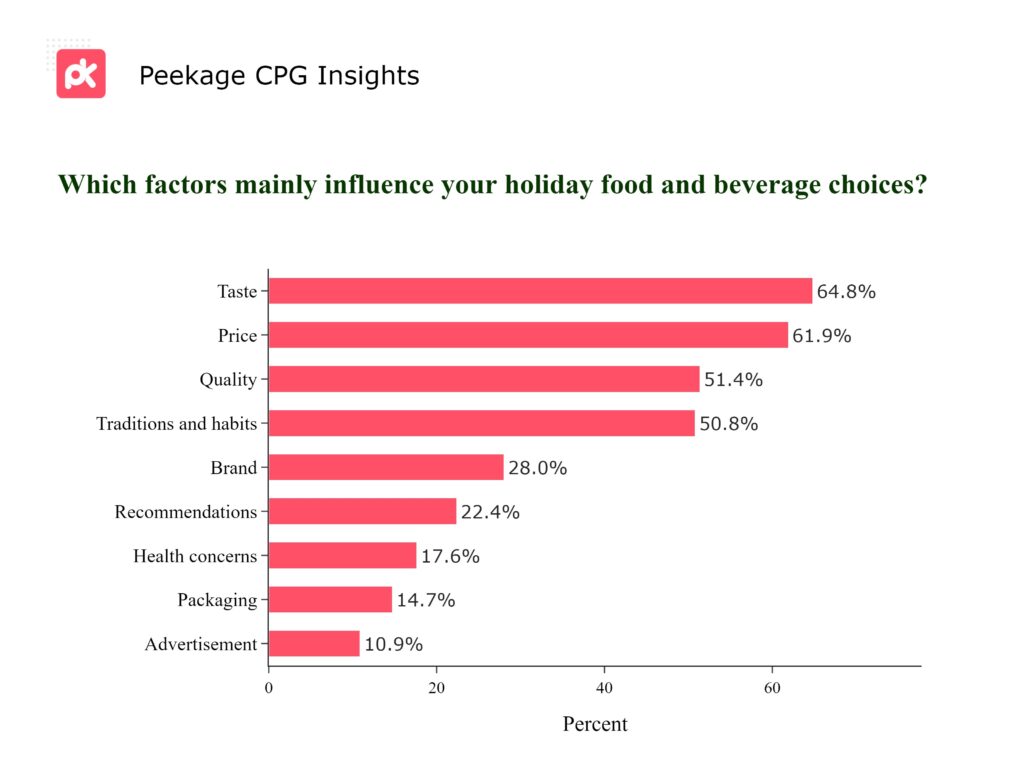
For holiday food and beverage choices, brands should prioritize flavor and align products with traditional tastes, while considering cost and quality. Additionally, leveraging brand loyalty and word-of-mouth, along with attention to health and packaging, can significantly influence consumer choices.
Preferred Stores for Holiday Shopping: Where's the Crowd?
Holiday shopping destinations are diverse, but Walmart takes the lead with 40.9% favoring it for its variety and value. Amazon isn't far behind, preferred by 24.1% for its convenience and vast selection. Target also makes a mark, drawing 10.7% of shoppers with its mix of quality and affordability. Costco's bulk buying appeal attracts 7.0%, ideal for stocking up for the season. The rest, including The Home Depot, Staples, Lowe's, Best Buy, and 7-Eleven, together with 'Other' options, cater to niche needs or specific purchases. It's a landscape dominated by big players where convenience, price, and product range reign supreme.
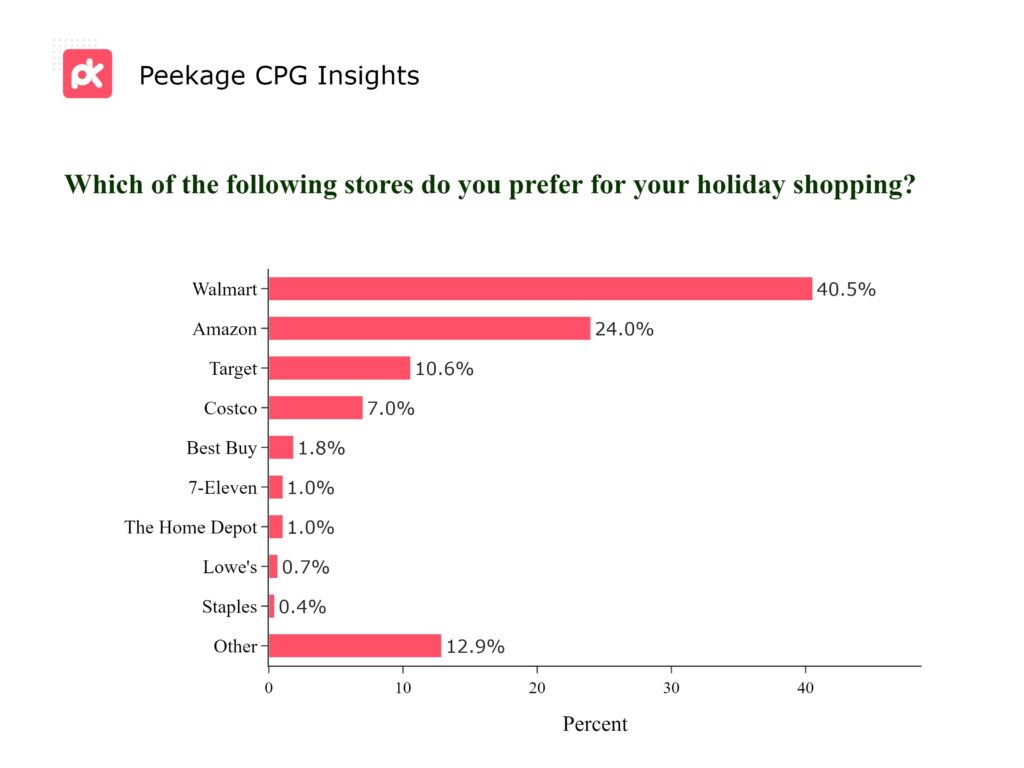
CPG brands should focus on partnering with or prioritizing stock at major retailers like Walmart (40.9%), Amazon (24.1%), and Target (10.7%) to leverage their widespread customer base, convenience, and perceived value. Additionally, acknowledging the unique appeals various niche outlets can help in reaching a broader and more diverse consumer segment.
Food Favorites for Holiday Feasting
When it comes to holiday food choices, tradition rules the table with 68.6% opting for classic meals like turkey, ham, or roast beef. But let's not forget the sweet tooth desserts and sweets are a must for 60.6%, and baked goods like cookies and cakes tempt 61.1%. Appetizers and finger foods also have their fans, with 53.5% adding them to the festive spread. Seafood specialties reel in 14.4%, while the same percentage seeks organic and health-focused options. International cuisine adds a twist for 11.2%, and vegan or vegetarian options cater to 8.9%. It's a smorgasbord of tastes, from time-honored recipes to health-conscious dishes.
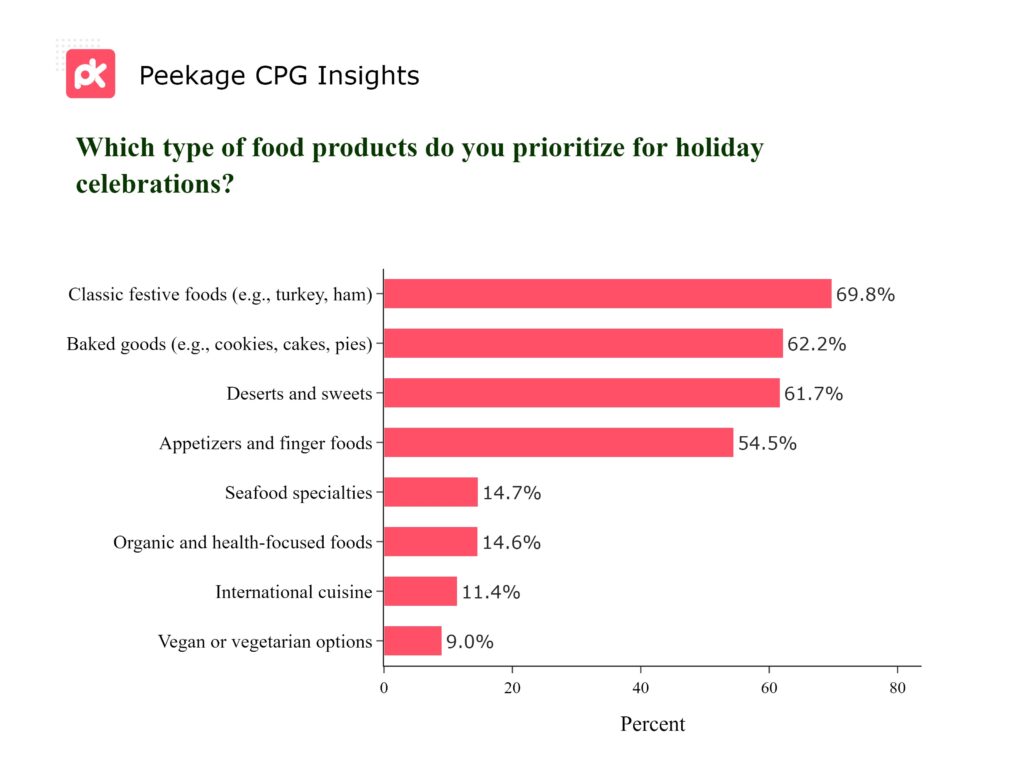
For the holidays, CPG brands should prioritize traditional dishes (68.6%) and cater to the high demand for desserts (60.6%) and baked goods (61.1%). Diversifying into appetizers, seafood, organic, international, and plant-based options can also attract specific consumer segments, reflecting the varied palate of holiday shoppers.
Age Dynamics in Holiday Shopping: Regular vs Holiday Specific Items
Across all age groups, an impressive majority, over 60%, opt for a mix of both regular and holiday-specific items in their festive shopping. This blend reflects a broad appeal for variety during the holiday season. However, delve into age specifics and a pattern emerges: those above 60 show a higher preference for purchasing regular items during the holidays. It hints at a possible inclination towards familiarity and tradition among older shoppers, contrasting with the more varied tastes of younger demographics.
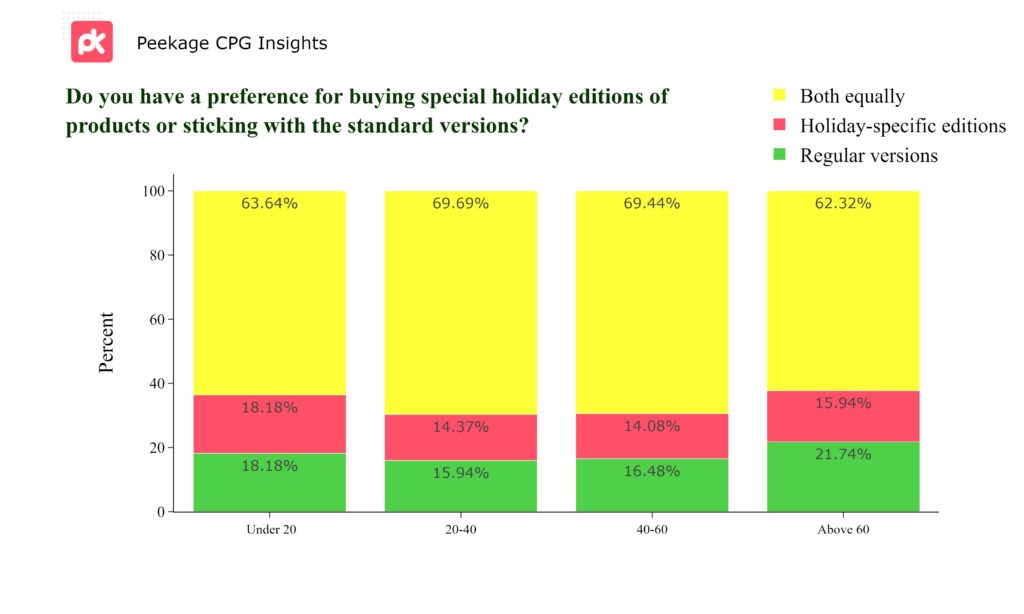
For CPG brands, it's key to recognize that over 60% across all age groups prefer a mix of regular and holiday-specific items, suggesting a broad market for varied product offerings. However, with those above 60 showing a preference for regular items and young adults showing interest in holiday specific items, brands should also consider strategies that honor tradition and familiarity, especially for this older demographic.
High-Income Holiday Shopping Trends
Here's a twist: about 6% of those earning above $100k actually skip holiday shopping altogether. It seems that even with more disposable income, not everyone gets into the festive shopping spirit. On the flip side, nearly half (48.8%) of this income group kick-start their holiday shopping about a week before the celebrations. This suggests a trend towards last-minute shopping among higher earners, possibly due to busy lifestyles or a preference for quick, decisive purchasing.
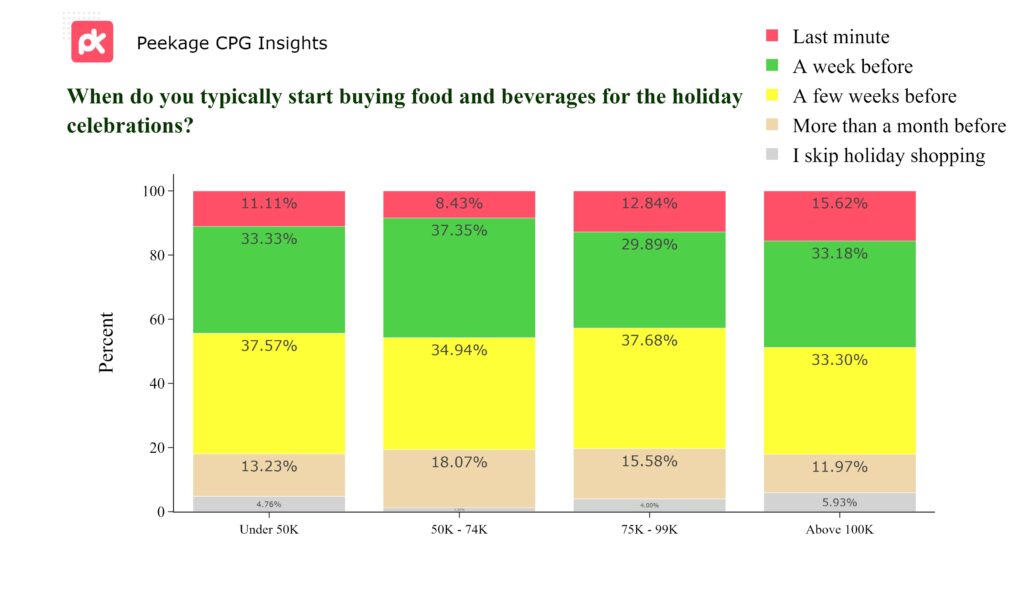
CPG brands should note that about 6% of high earners ($100k+) skip holiday shopping, while nearly half start just a week before, indicating a significant opportunity for targeted last-minute marketing strategies and promotions to capture the attention of these time-constrained, higher-income consumers.
Last-Minute Shopping: A Trend Among 20-40 Year Olds
Here's a timely insight: those between the ages of 20 and 40 tend to do their holiday shopping at the eleventh hour, predominantly in the week leading up to the holiday. This trend of last-minute shopping is less common in other age groups. This behavior might reflect the busy lifestyles, decision-making patterns, or a preference for spontaneous shopping among younger adults. In contrast, older age groups tend to plan and shop earlier, possibly valuing preparation and avoidance of the holiday rush. Understanding these age-specific shopping habits can be crucial for retailers and brands in timing their promotions and stock availability.
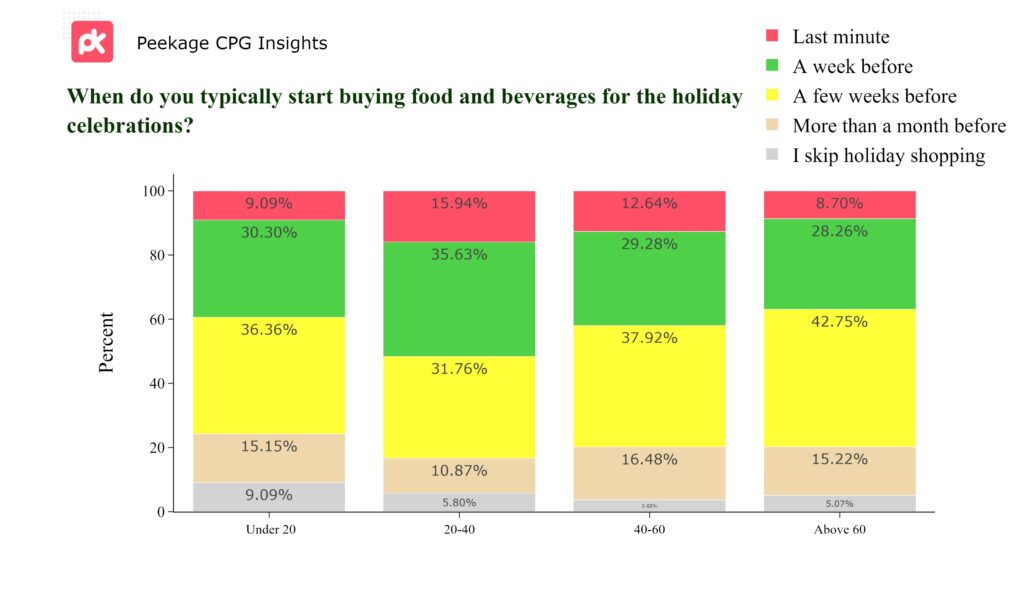
Retailers and brands should note that individuals aged 20-40 often engage in last-minute holiday shopping, a trend less observed in older demographics. This suggests tailoring marketing campaigns and ensuring stock availability for late shoppers in this age group. Conversely, targeting older consumers with earlier promotions and preparedness for pre-holiday rushes can effectively meet their preference for advanced planning.
Health and Nutrition: A Priority Across All Income Levels
Contrary to common perceptions, the importance of health and nutrition in food and beverage choices isn't exclusive to higher income groups. It's a significant consideration across all income intervals. This trend reflects a widespread awareness and prioritization of healthful eating, transcending economic boundaries. It suggests that consumers, regardless of their income, are increasingly seeking foods that offer nutritional benefits, aligning with a broader societal shift towards health and wellness. For brands, this underscores the need to emphasize healthful attributes in their products, catering to a universally health-conscious consumer base.
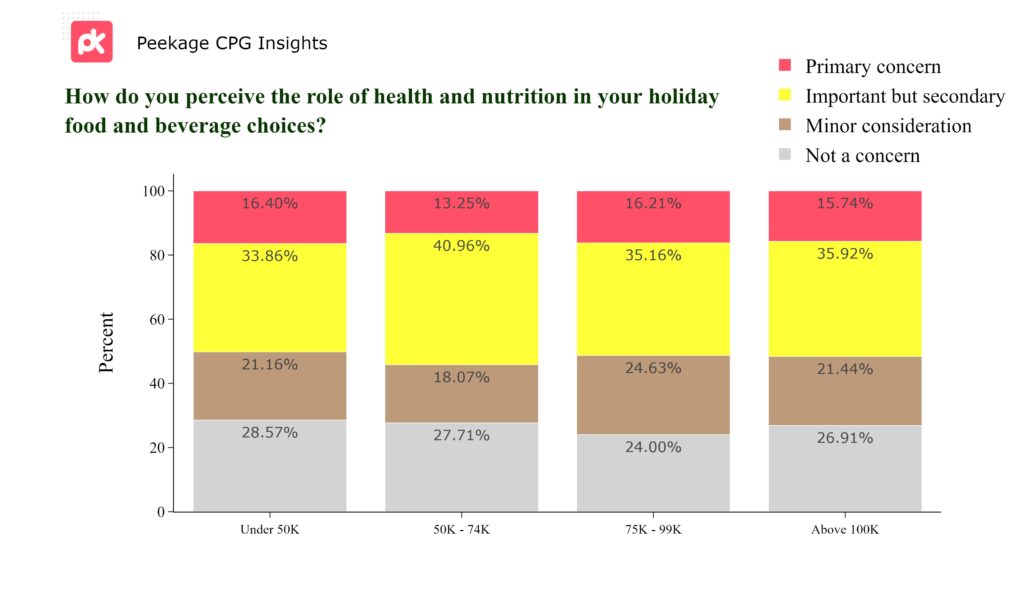
Health and nutrition are key factors in food and beverage choices across all income levels, not just higher earners. CPG brands should universally emphasize the healthful attributes of their products, catering to a broad, health-conscious consumer base in tune with the societal shift towards wellness.
Age and Health: Evolving Priorities in Food & Beverage Choices
As consumers age, their focus on health and nutrition in food and beverage choices becomes more pronounced. This trend reflects a growing awareness and priority for well-being among older demographics. While younger consumers may prioritize taste, convenience, or novelty in their holiday eating, older individuals increasingly weigh the health benefits and nutritional content of their festive feasts. This shift underscores the importance for brands to cater to varied health considerations across different age groups, especially during the indulgent holiday season.
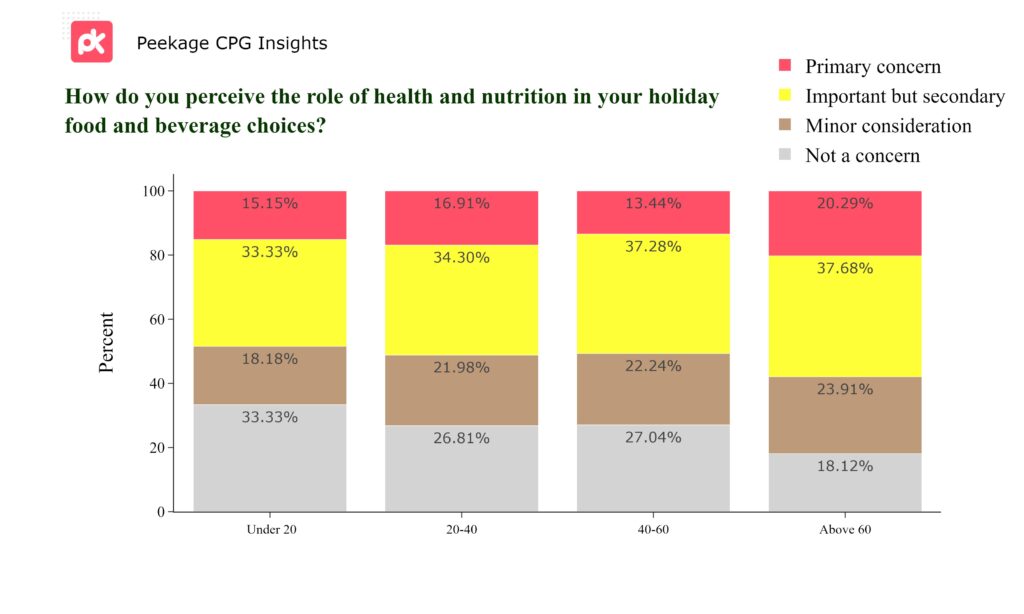
CPG brands should adapt their offerings to meet the evolving health and nutrition preferences across age groups. For older consumers, emphasizing health benefits and nutritional content becomes more crucial, while younger demographics might lean towards taste, convenience, and novelty. Tailoring products and marketing strategies to these varied health priorities can enhance appeal and meet the diverse needs of consumers during the festive season.
U.S. Consumers and Last-Minute Holiday Shopping
When it comes to holiday shopping, a notable trend among U.S. consumers is the tendency to wait until the eleventh hour, particularly the week just before the holiday. This pattern, more pronounced compared to other nationalities, reflects a tendency towards last-minute shopping among Americans. This could be attributed to a variety of factors, such as busy lifestyles, a preference for spontaneous decision-making, or even reliance on quick shipping options. Understanding this trend is crucial for retailers and brands, as it suggests the importance of maintaining stock availability and efficient customer service as the holiday season peaks.
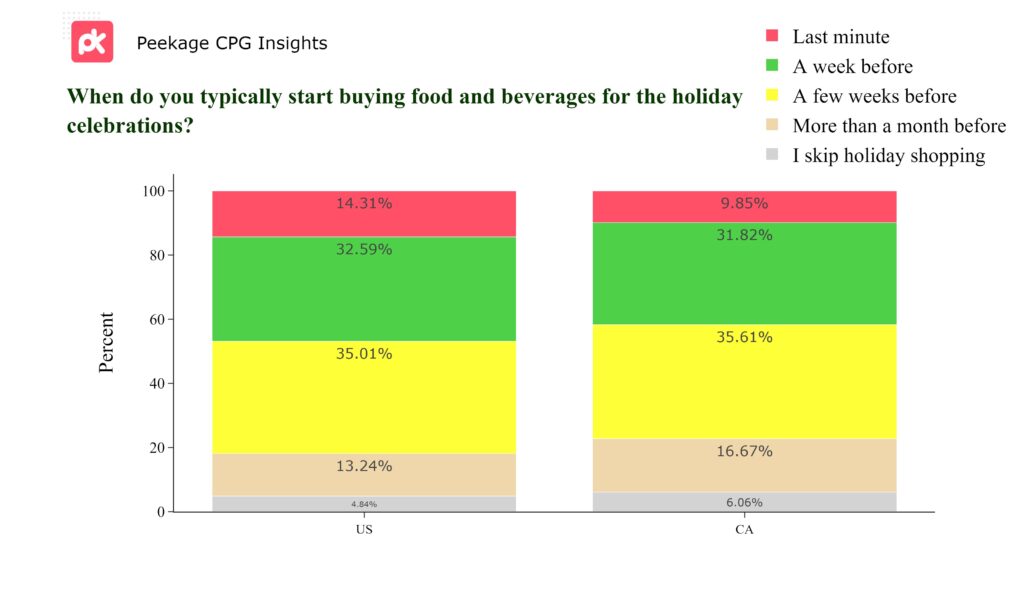
The trend of last-minute holiday shopping among U.S. consumers highlights the need for CPG brands to ensure robust stock availability and efficient customer service in the lead-up to the holidays. Tailoring marketing and logistics to accommodate this eleventh-hour surge can be a key strategy for success in the American market.
Convenience in Food Choices: Age Matters
In the landscape of convenience food, age plays a pivotal role. For those under 20, the allure of ready-to-eat meals is strongest, highlighting a preference for quick, hassle-free eating options. As people age, however, the importance placed on convenience gradually diminishes. Older demographics may prioritize aspects like health, quality, or the experience of cooking over the sheer convenience of pre-prepared meals. This trend suggests a shift from valuing time-saving options to appreciating other elements of the food and beverage experience as consumers mature.
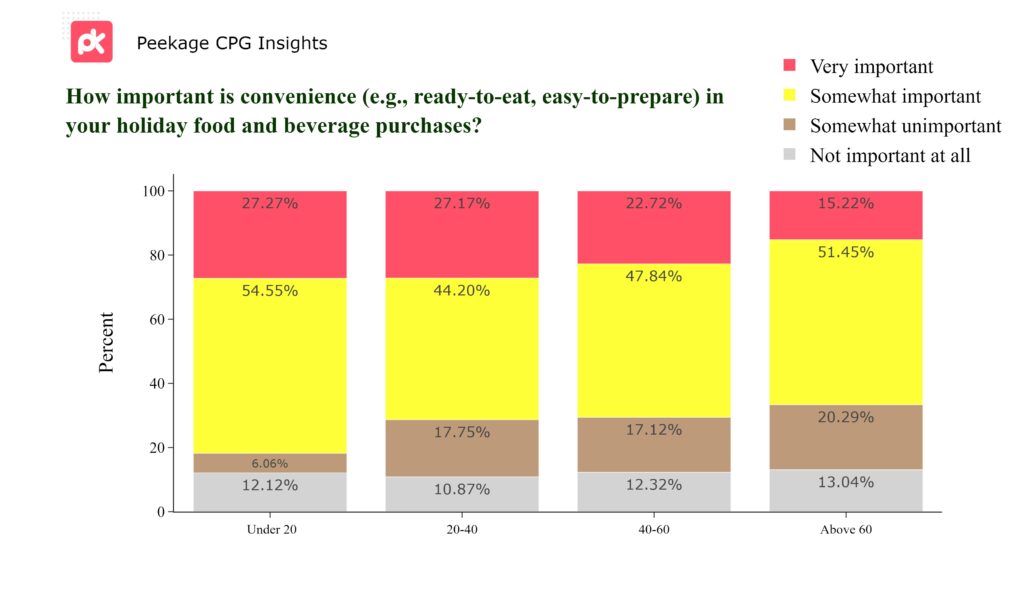
CPG brands should adapt their product offerings to align with the growing health focus among older consumers, emphasizing nutritional benefits in their marketing and product development. Catering to the diverse health priorities of different age groups, especially during the holidays, can enhance brand appeal and meet evolving consumer needs.
Convenience in Meals: A U.S. vs Canada Comparison
When it comes to convenience in food choices, there's a notable cross-border difference: Americans display a stronger preference for ready-to-eat and easy-to-prepare meals compared to their Canadian counterparts. This trend suggests a higher prioritization of quick, convenient meal options in the United States, possibly reflecting faster-paced lifestyles or different cultural attitudes towards meal preparation. In contrast, Canadians may place more emphasis on other aspects of their food choices, such as quality, ingredients, or the cooking process itself.
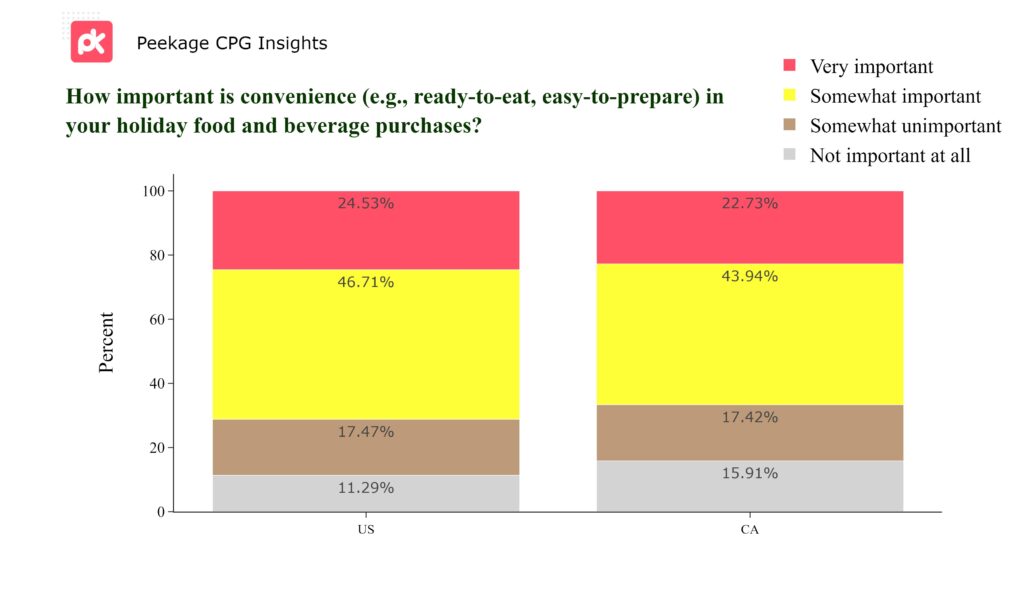
CPG brands should note the marked preference for convenience in the U.S., with Americans favoring ready-to-eat and easy-to-prepare meals more than Canadians. This indicates a potential focus area for brands in the U.S. market, catering to a faster-paced lifestyle. Conversely, in Canada, emphasizing aspects like quality, ingredients, and the cooking experience could resonate more with consumers, reflecting differing cultural attitudes towards food and meal preparation.
Holiday Deal Hunting: U.S. vs Canada Trends
In the realm of snagging holiday deals, Canadians show a stronger inclination to shop during specific times like Black Friday and Cyber Monday compared to their American neighbors. This indicates a more pronounced deal-seeking behavior among Canadian shoppers, who may be more strategic in timing their purchases to coincide with these major discount events. On the other hand, U.S. consumers, while still participating in these sales, may spread their holiday shopping more evenly throughout the season or be less driven by these specific discount periods
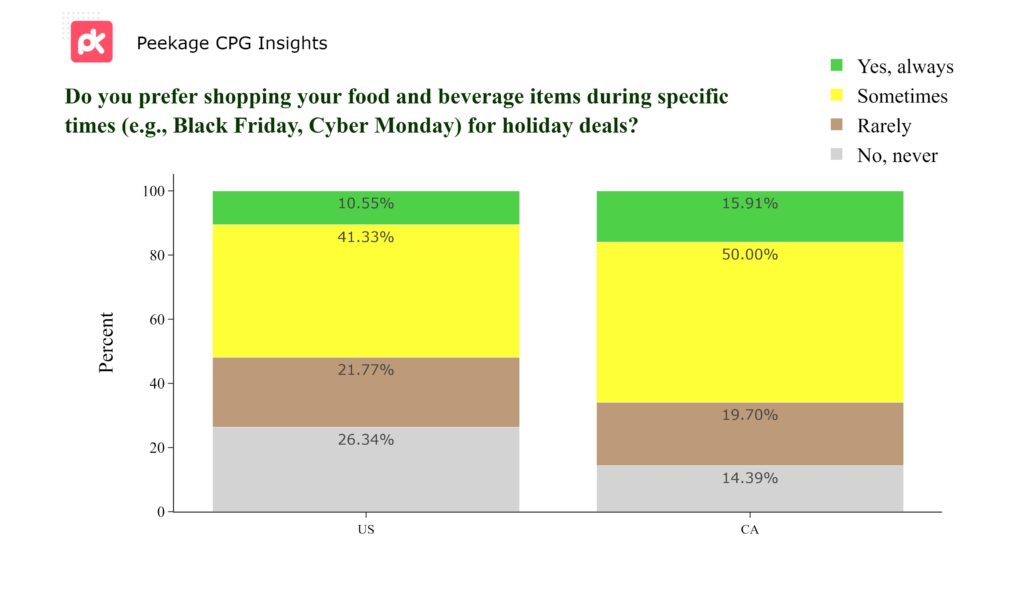
CPG brands should recognize that Canadian consumers exhibit a stronger tendency to focus their shopping around major sales events like Black Friday and Cyber Monday. This deal-seeking behavior suggests the importance of targeting these specific periods with strategic promotions in Canada. In contrast, in the U.S., a more consistent approach throughout the holiday season may be effective, as American consumers tend to distribute their shopping more evenly and may be less motivated by these specific discount occasions.
Age and Timing of Holiday Shopping: A Changing Interest
A fascinating trend emerges with age: as people get older, their interest in timing their food and beverage purchases to align with holiday deals, like Black Friday or Cyber Monday, diminishes. Younger shoppers display more enthusiasm for these deal-centric periods, possibly driven by a desire for savings or the thrill of the hunt. In contrast, older consumers tend to be less influenced by these specific shopping events, possibly valuing convenience, routine, or quality over the pursuit of deals. This shift in priorities highlights the importance of understanding age-specific preferences in holiday shopping behavior.
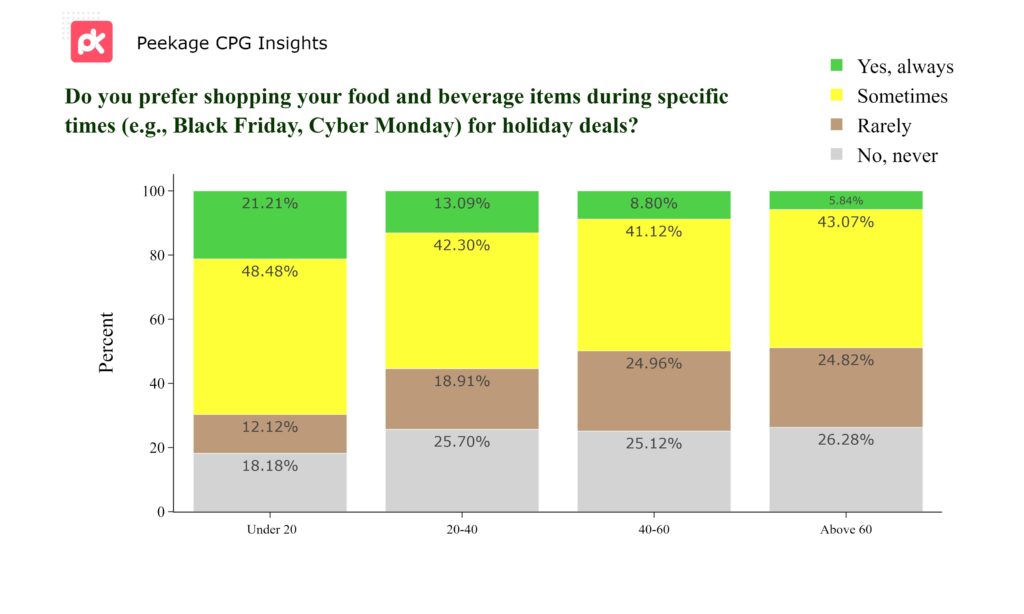
In planning holiday promotions, CPG brands should note that younger consumers are more inclined to align purchases with deal-centric periods like Black Friday, driven by savings or excitement. In contrast, older demographics may prioritize factors like convenience or quality, showing less interest in these specific sale events.
Holiday Food & Beverage Expenditure: Canada vs. U.S.
When it comes to holiday spending on food and beverages, there's an interesting similarity between Canadians and Americans. The per capita expenditure in both countries appears quite comparable, indicating a similar level of investment in festive culinary delights. This parallel suggests that despite cultural or regional differences, the value placed on food and beverage during the holiday season is a shared attribute between these neighbors. This insight can be valuable for businesses and marketers in both countries, highlighting the universal appeal of holiday feasting and the potential for cross-border marketing strategies.




